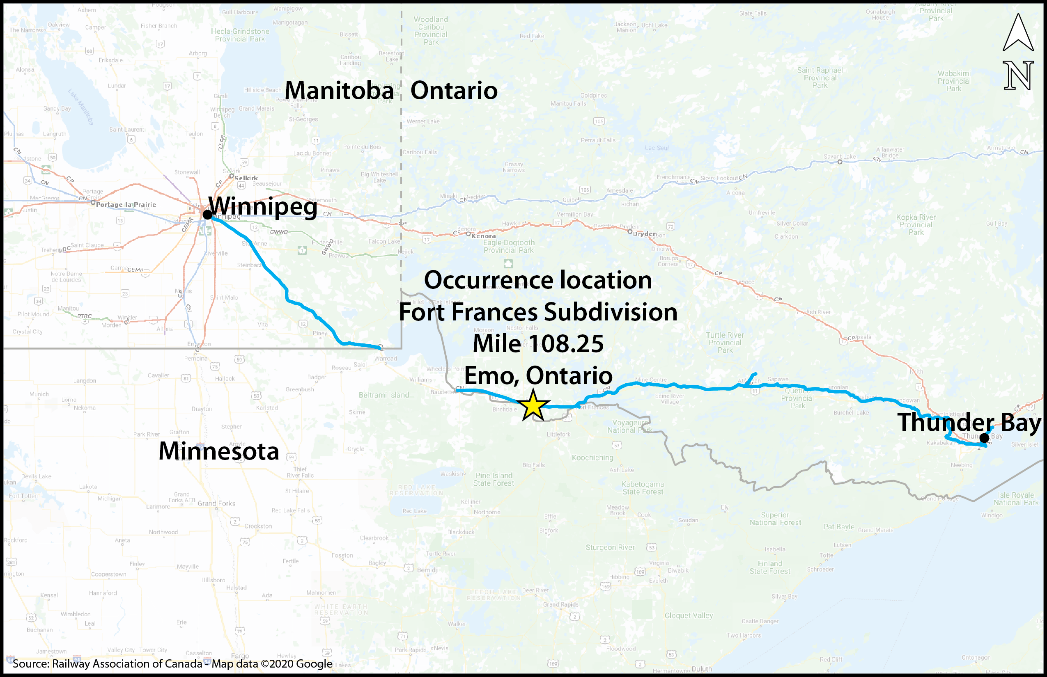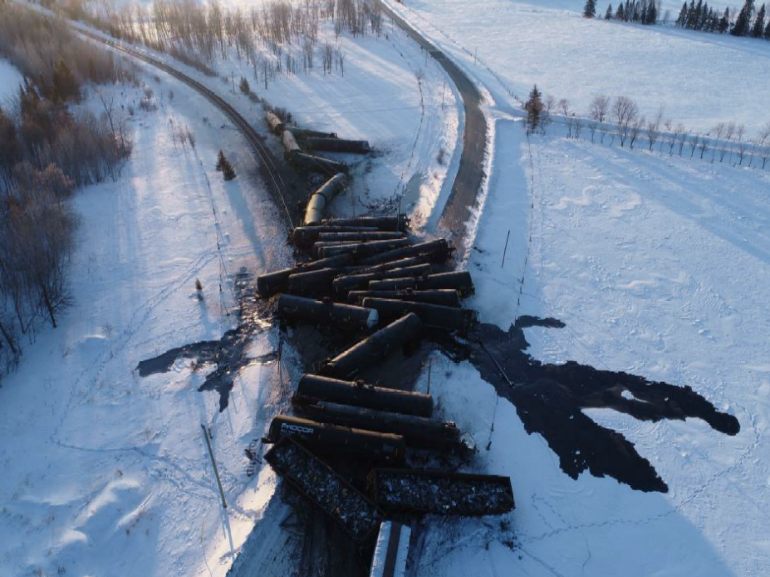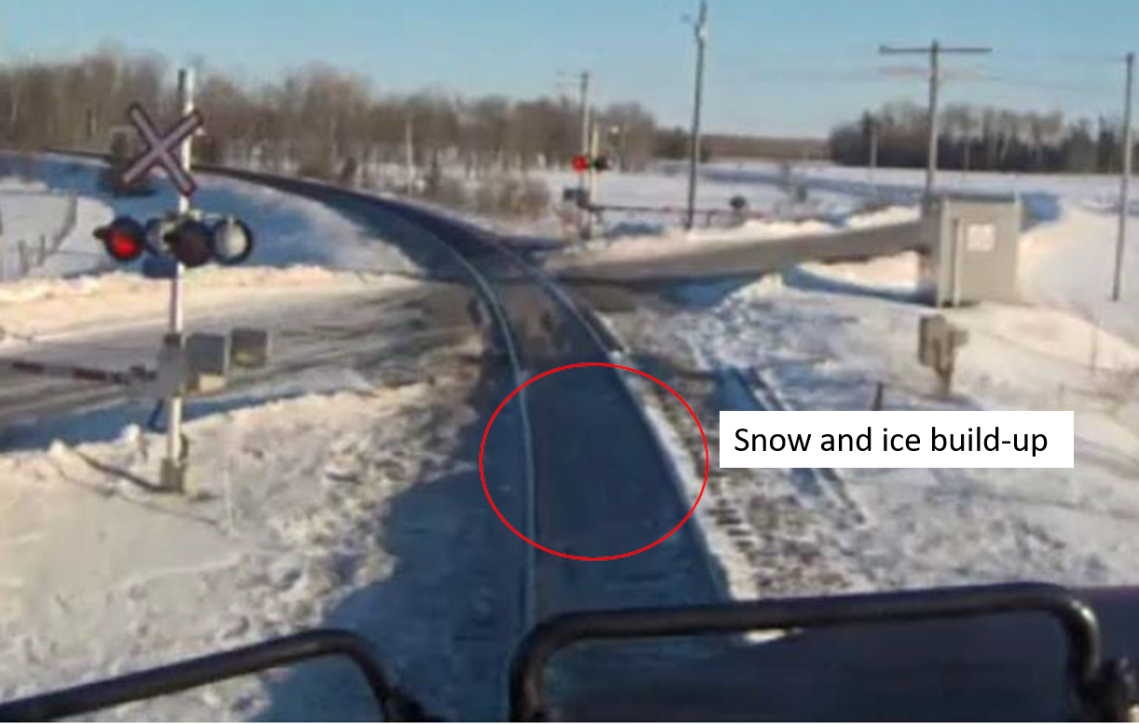Main-track train derailment
Canadian National Railway Company
Train X35041-18
Mile 108.25, Fort Frances Subdivision
Emo, Ontario
The Transportation Safety Board of Canada (TSB) investigated this occurrence for the purpose of advancing transportation safety. It is not the function of the Board to assign fault or determine civil or criminal liability. This report is not created for use in the context of legal, disciplinary or other proceedings. See Ownership and use of content. Masculine pronouns and position titles may be used to signify all genders to comply with the Canadian Transportation Accident Investigation and Safety Board Act (S.C. 1989, c. 3).
The occurrence
On 18 February 2020, a Canadian National Railway Company (CN) operating crew was ordered for 1600 Central Standard TimeFootnote 1 in Winnipeg, Manitoba, for train X35041-18. The key trainFootnote 2 was to operate on a key routeFootnote 3 eastward from Winnipeg to Fort Frances, Ontario, on CN’s Sprague and Fort Frances subdivisions. The train crew consisted of a locomotive engineer and a conductor. Both crew members were qualified for their positions, met fitness and rest requirements, and were familiar with the territory.
The train was powered by 2 head-end locomotives and 1 distributed-power locomotive in the 103rd position behind the head-end locomotives. The train was hauling 144 freight cars (132 loaded cars and 12 empty cars), weighed 18 103 tons, and was 9228 feet long. The loaded cars included 73 dangerous goods (DG) tank cars marshalled within the first 80 cars of the train. Of the 73 tank cars loaded with DG, 38 were loaded with petroleum crude oil (UN 1267) located in the 38th to 75th positions behind the locomotives.Footnote 4 The key train conformed to requirements set forth in Transport Canada (TC) Ministerial Order MO 20-03.Footnote 5
At 2036, while proceeding at 44 mph,Footnote 6 the train was negotiating an approximately 4° left-hand curve (in the direction of travel) as it traversed the Ontario provincial highway 602 public automated crossing (Mile 108.22) when a train-initiated emergency air brake application occurred near the township of Emo, Ontario (Figure 1).
Following the emergency air brake application, the crew initiated an emergency radio broadcast as required. After the train came to a stop, the conductor inspected the train and determined that a derailment had occurred and that petroleum crude oil was leaking from some of the derailed tank cars. Six homes in the area were evacuated as a precautionary measure. There was no fire, and no injuries were reported.
Weather
At the time of the accident, the skies were clear and the temperature was −27 °C. In the vicinity of the derailment, the area had recently experienced several freeze-thaw cycles. Between 10 February 2020 and 18 February 2020, the average daytime temperature was about −6 °C and the average nighttime temperature was about −27 °C.
Site examination
Site examination identified that a total of 33 cars, located in positions 48 to 80, had derailed. Of the derailed cars, 29 were DG tank cars in the 48th to 76th positions, and 4 were non-DG cars. The first 28 DG tank cars (48th to 75th cars) were loaded with petroleum crude oil, and the 76th car was loaded with asphalt (UN 3257).
Smearing and gouging was observed on the tank car wheel rim faces of the 48th to the 51st cars. The marks indicated that the wheels of the trailing truck of the 48th car and the leading truck of the 49th car were likely the first to derail and, as they dropped into the gauge between the rails while moving forward, they spread rail behind them. All wheels of the 50th and 51st cars derailed, then subsequently contacted the Ontario provincial highway 602 crossing surface and rerailed themselves.
The 48th to 51st cars remained upright on the rails and attached to the head end of the train. The train separated behind the 51st car and came to a stop, creating a gap of about 1500 feet between the 51st and 52nd car. The trailing 52nd to 80th cars derailed predominantly toward the high side (the south side) of the curve. The tank cars located in the 75th and 76th positions and the 4 non-DG cars located in the 77th to 80th positions remained upright.
The 52nd to 74th cars, which were carrying petroleum crude oil, came to rest in various positions scattered over a distance of approximately 1000 feet (Figure 2). Six cars released a total of 84 464 U.S. gallons (319 731 L) of product.
In the area of Mile 108.25, just west of the crossing (Mile 108.22) snow and ice build-up was observed adjacent to the high rail (the south rail), which can occur during winter operations. Closer examination revealed that the snow and ice had built up between the underside of the rail base and the tie plate rail seats. This caused the rail to become unseated from the tie plate and left the rail susceptible to gauge spreading under the load of the train, which led to the derailment. This is a phenomenon commonly referred to in the rail industry as “ice jacking”.
No mechanical rolling stock defects were observed.
Information about the tank cars and the product released
Most of the 23 derailed tank cars that came to rest in various positions were DOT 111A100W1 cars that met the CPC-1232 design standard.Footnote 7 Furthermore, 2 of the tank cars were retrofitted and identified as DOT 117R100W cars.Footnote 8
It was determined that 6 of the 23 derailed tank cars had released product after sustaining damage. Four of the 6 cars released most of their product, and the other 2 cars released only small amounts (Table 1).
| Car position | Car initial and number | Stencilled tank car specification | Damage to tank car | Shipped (U.S. gallons) | Released (U.S. gallons) | Shipped (L) | Released (L) |
|---|---|---|---|---|---|---|---|
| 60 | TILX 280872 | DOT 111A100W1 | Shell crack – A-end right side | 21 894 | 2 500 | 82 878 | 9 464 |
| 66 | CBTX 716287 | DOT 111S100W1 | Bottom outlet valve opened in accident | 21 556 | 1 000 | 81 598 | 3 785 |
| 67 | TILX 280829 | DOT 111A100W1 | Coupler puncture in shell – B-end left side, lower side | 21 815 | 19 503 | 82 579 | 73 827 |
| 70 | PROX 51252 | DOT 111S100W1 | Bottom outlet valve opened in accident | 22 234 | 21 865 | 84 165 | 82 768 |
| 71 | GBRX 704360 | DOT 117R100W | Coupler punctures in shell - both lower middle sides | 22 168 | 18 602 | 83 915 | 70 416 |
| 72 | GBRX 704356 | DOT 117R100W | Tear in tank bottom | 22 051 | 20 994 | 83 472 | 79 471 |
| Totals | 131 718 | 84 464 | 498 607 | 319 731 | |||
Recorded information
A review of the locomotive event recorder data determined that the train was handled in accordance with all regulatory and company requirements, with no operating anomalies noted.
Forward-facing video on the lead locomotive of the occurrence train and an earlier train
A review of the forward-facing video on the train’s lead locomotive as it approached the crossing was inconclusive, because the video quality was affected by the darkness.
Earlier in the day at about 1600, the previous eastbound CN train, Q11831-16 (train 118), safely traversed the occurrence site during daylight hours when the ambient temperature was −14 °C. A review of the video from the forward-facing camera on the lead locomotive of train 118 revealed the presence of snow and ice build-up just before and adjacent to the high rail (the south rail) in the vicinity of the suspected initial point of derailment at about Mile 108.25 (Figure 3). Any accumulation of snow along the rail base can mask a build-up of ice between the underside of the rail base and tie plate rail seats, which makes ice-jacking difficult to detect.
Subdivision and track information
The Fort Frances Subdivision extends from Atikokan, Ontario (Mile 0.0), to Rainy River, Ontario (Mile 143.6). Track in the vicinity of the derailment site was single main track governed by centralized traffic control (CTC) as authorized by Canadian Rail Operating Rules (CROR) and supervised by a rail traffic controller (RTC) located in Edmonton, Alberta.
The track was classified as class 4, according to the TC-approved Rules Respecting Track Safety, otherwise known as the Track Safety Rules (TSR).Footnote 9 The track structure consisted of 136-pound continuous welded rail manufactured by Nippon Steel Corporation in 2012 and Rocky Mountain Steel in 2017. The rail was set in 12-inch double-shouldered tie plates anchored with 3 spikes per plate and sat on hardwood ties in good condition. The ballast consisted of crushed rock with full cribs and the shoulders extended 14 inches beyond the end of the ties.
The authorized timetable speed in the vicinity of the derailment site was 50 mph for freight trains. An average of 15 freight trains per day operated on the subdivision.
Track maintenance
Track in the vicinity of the derailment site met or exceeded the minimum standards of the TSR and CN’s Engineering Track Standards (ETS). On 02 February 2020, 3 joints were installed near the west end of the provincial highway 602 crossing (Mile 108.22), at about Mile 108.25. Two joints secured a plug rail that had been installed in the low rail (the north rail). The other joint was installed to repair a rail break in the high rail (the south rail) in preparation for a weld repair. There were no track anomalies associated with either joint.
Track inspection
Track inspections were performed regularly and the frequency met or exceeded the minimum requirements of the TSR and CN’s ETS. The following automated track inspections had been performed in the vicinity of the derailment site since December 2019:
- On 11 December 2019, a CN heavy track geometry inspection was conducted, with no urgent or near urgent defects noted.
- On 11 and 18 January 2020, light geometry inspections were conducted, with no urgent or near urgent defects noted.
- On 20 January 2020 a heavy geometry inspection was conducted including loaded gauge testing with no defects noted.
- On 05, 06 and 12 February 2020, rail flaw ultrasonic inspections were performed, with no defects noted.
The most recent visual inspection of the track was on 16 February 2020, with no defects noted.
Ice jacking
A combination of weather conditions and track conditions is required for ice jacking to develop. In winter, roadway snow clearing activities frequently push road sand, salt, and snow off to the ends of a crossing and onto railway tracks. The presence of road salt can accelerate snow melt, which sometimes leaves water pooling alongside the track. When the track is exposed to freeze/thaw cycles, this can contribute to ice build-up along the base of the rail.
When water is present, the passage of trains produces a pumping action that can promote water ingress between the underside of the rail base and the tie plate rail seat, where the water freezes. When a number of these cycles occur, it can produce a build-up of ice that physically lifts the rail from the tie plate rail seat, which makes the rail susceptible to gauge spreading when subjected to loading as a train passes. The TSB has observed this phenomenon in at least 1 other investigation.Footnote 10
Although railways are aware of this condition and track supervisors are trained to recognize it, the condition can still be difficult to detect during a visual track inspection when snow is present.
Safety action taken
Following the occurrence and CN’s incident investigation, CN clarified inspection expectations in its ETS to require zone and production gangs that are doing work on one rail to inspect both rails to ensure that they comply with track standards and that no hazards exist.
This report concludes the Transportation Safety Board of Canada’s investigation into this occurrence. The Board authorized the release of this report on . It was officially released on .


